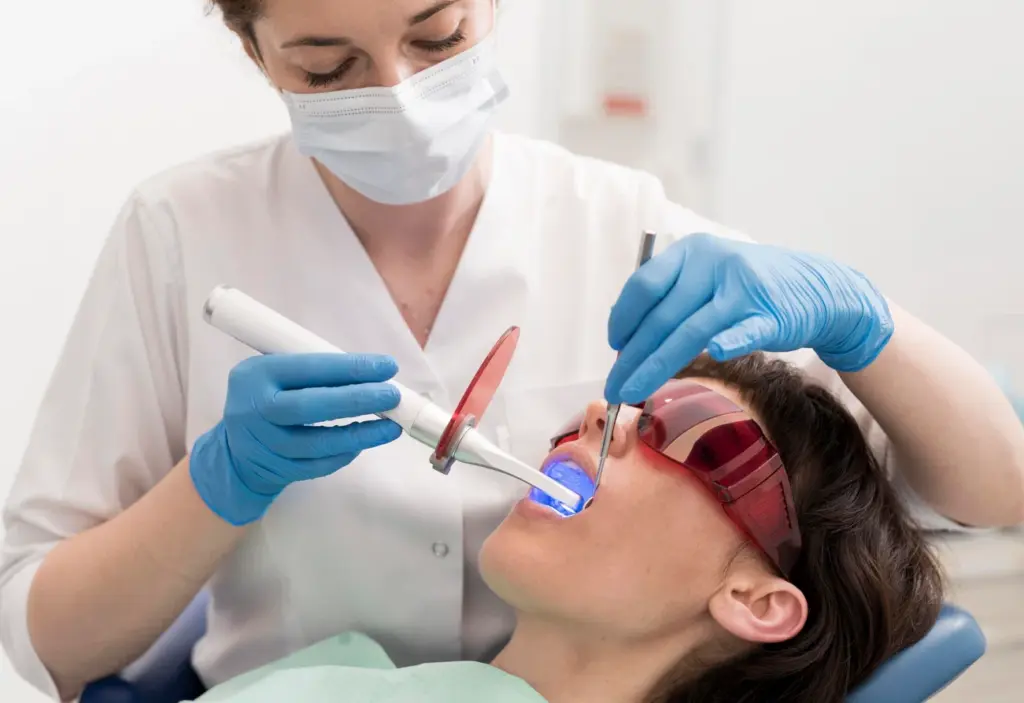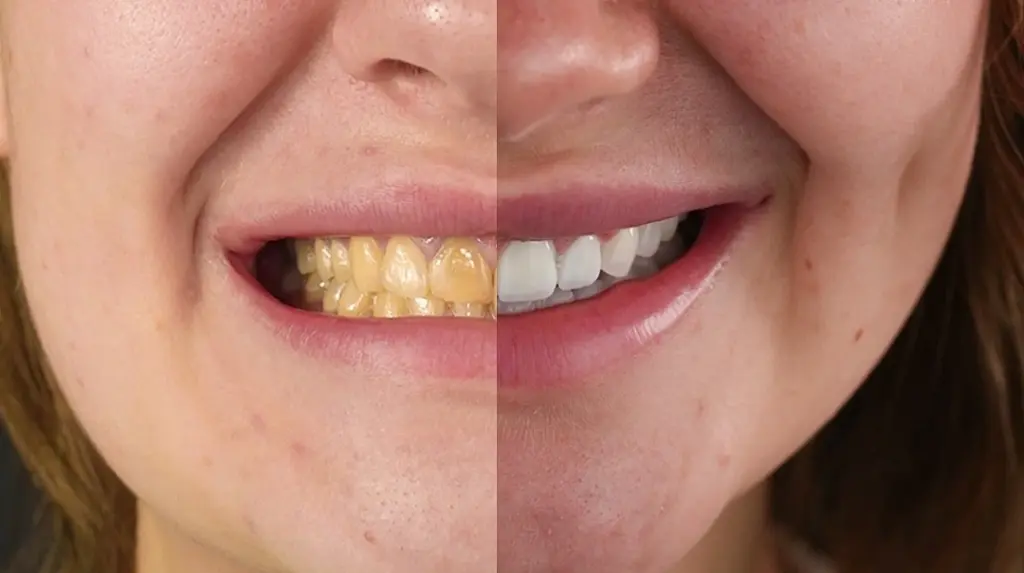What Is Deep Cleaning Teeth?

Deep cleaning is a dental term most commonly referred to as scaling and root planing. It is a non-surgical process that dentists and periodontists use to treat periodontal disease. While regular teeth cleaning is done at your dentist’s or dental hygienist’s office, as they only clean the visible portions of your teeth, deep cleaning refers to a targeted cleaning process at the roots of your teeth, where plaque, tartar, and bacteria may hide.
Deep cleaning is required when the gums have receded or pulled away from their place on the teeth, forming pockets in which bacteria can multiply and find a dwelling. Failure to treat these swollen and diseased gums in a very early stage can potentially lead to chronic gum inflammation, loss of bone, or even the loss of teeth altogether. Even if it sounds a bit scary or intimidating, deep cleaning is an incredibly safe and efficient method of restoring your gums and teeth’s health to normal and preventing further dental problems from occurring.
How Does Deep Cleaning Work?
Deep cleaning of teeth usually involves a two-step procedure comprising scaling and root planing. Depending on the extent of the gums’ damage and pocketing, your dentist or periodontist may perform the procedure in one or two visits, sometimes dividing teeth cleaning into quadrants to cover one portion of your mouth at a time. This will ensure that the right amount of healing will happen for the gums before performing the cleaning procedure on the next portion.
1. Scaling: This is a stage of deep-root cleaning that involves physical removal of the plaque deposits and hard tartar or “calculus” which may cover the teeth as well as underneath the gums. The tools used in this procedure are usually special, some of them being ultrasonic scalers, to do a thorough cleaning in those areas that other methods, such as brushing or flossing, cannot reach. The dentist also uses these tools to scrape away the deposits meticulously, ensuring that no dental plaque is left on your teeth.
2. Root Planing: Once scaling is done, root planing is a process in which the tooth roots are adjusted to be smooth. This process is important because it prevents bacteria from reattaching themselves to the surface and helps the gums heal and come back to a clean surface. Smooth roots also enable the gums to attach to this area, preventing bacteria or plaque from accumulating there again in the future.
When you visit a dental clinic for deep cleaning, your dentist may give you local anesthesia to lessen discomfort and improve your experience. Some dentists may also use antibacterial solutions to aid healing after surgery. Depending on the needs and demands of the patient’s case, they may also use laser treatment to provide more accuracy and reduce the healing period.
Is Deep Cleaning Teeth Necessary?

If you don’t feel any pain or discomfort, you might wonder if it isn’t too much for deep cleaning, but the probability is that the dentist would have suggested it in case it was necessary. The beginning stages of gum disease can be stealthy, hence the importance of regular checkups to catch them before they become major problems. Most of the time, the infrastructure may not be enough to recognize signs like swollen gums, so detecting these issues early through the right dental visitation will make a difference.
Deep cleaning becomes necessary when you notice;
- Gum pockets with a depth of more than 4mm
- Gums that bleed easily, are puffy, or feel painful
- Presence of continuing bad breath that does not go away with the use of dental products
- X-ray images showing signs of bone loss surrounding one’s teeth
- Increased calculus or tartar under the gum line that cannot be cleaned by brushing alone
If your dentist or periodontist recommends deep cleaning, don’t panic. This is simply a way of stopping the progression of periodontitis which, when left untreated, can affect your overall body health and hygiene.
Deep Cleaning vs. Regular Cleaning of Teeth
People often confuse regular cleanings (prophylaxis) with deep cleaning (scaling and root planing), but they are quite different in purpose, technique, and outcome.
| Feature | Regular Cleaning | Deep Cleaning (Scaling & Root Planing) |
|---|---|---|
| Purpose | Preventive maintenance | Treatment of active gum disease |
| Area Covered | Above the gumline | Below the gumline |
| Frequency | Every 6 months (typically) | As needed, based on gum condition |
| Anesthesia Needed? | No | Often yes |
| Signs It’s Needed | Healthy gums | Bleeding, pockets, tartar, bad breath |
| Tools Used | Polisher, manual scaler | Ultrasonic scalers, curettes |
A regular cleaning keeps your teeth looking and feeling clean. A deep cleaning saves your teeth and gums from further damage caused by infection and inflammation.
Disadvantages of Deep Cleaning Teeth
If deep cleaning is a key procedure for you, still, you should still keep in mind the negative aspects, particularly if you happen to be nervous around the dentist.
- Temporary Tooth Sensitivity:
Feeling pain from both hot and cold items or drinks shortly after the treatment is a usual outcome. The feeling can stay with you from a few days to a couple of weeks.
- Gum Soreness and Inflammation:
As deep cleaning is executed below the gum line, there is a possibility that you will get gum soreness, some swelling, or even minor bleeding for a short time.
- Gum Recession:
In a few cases, when the inflammation subsides, the gums may retract a bit, thus, more of the tooth surfaces are exposed, and they look longer. It is a natural and desired outcome of the treatment and not a complication.
- Risk of Infection (Rare):
If there is no proper aftercare, the patient may encounter an infection, but the chance is very slight. Your dentist might provide you with an antimicrobial mouthwash or a course of antibiotics as a safety measure.
- Multiple Visits:
Some serious conditions might demand that they undergo several treatments to finish. This problem could potentially mean that not only is a longer duration necessary but also the cost that will be dealt with might be higher compared with an ordinary cleaning procedure.
Nonetheless, the virtues significantly outnumber all the momentary drawbacks, particularly those regarding the protection of your teeth and jawbone.
Deep Cleaning Teeth Before and After

Are you curious about what the outcome of deep cleaning is like? What usually changes before and after deep cleaning is described below:
Before Deep Cleaning:
- Red, puffy, and spontaneous bleeding gums
- Deep gum pockets that act as a haven for bad bacteria
- Extremely bad breath that remains for a long period
- Wobbly teeth or discomfort during the meal
- Presence of plaque and tartar under the gumline
After Deep Cleaning:
- Their gums gain a natural color, become tight, and look healthy
- The recession of the gum pocket depth
- There’s a fresher smell of breath
- Less blood during toothbrushing or interdental cleaning
- More comfortable while eating
Before-and-after photo demonstrations of deep cleaning show how big the difference in gum health is after the treatment. Many people experience a fresher mouth and cleaning within a couple of days.
Final Thoughts
Deep cleaning is not just a regular dental service; it is a pivotal procedure against periodontitis and a sure way to keep your teeth for many years to come. Advice from your dentist to go through this procedure is not to be overlooked. Early treatments can prevent you from further enhanced and expensive procedures, such as gum surgery or tooth replacement, in the later stages of the disease.
Frequently Asked Questions About Deep Cleaning Teeth
Regular cleaning is the process by which tooth decay and dental deposits are removed from the surface of the teeth above the gum line, primarily to prevent the occurrence of harmful bacteria. The deep cleaning process involves the area below the edges of the gums to treat gum disease by getting rid of the germs and smoothing the roots of the tooth.
Typically, deep cleaning is done using local anesthesia, so the patient will not feel pain during the procedure. In the aftermath, there may be a feeling of mild soreness or sensitivity for a couple of days; nothing more, nothing less.
Evidence of deep gum pockets, bleeding gums, or gum disease at any of the points could be the telltale signs that you need a deep cleaning. In general, an X-ray and clinical testing will be required to confirm the necessity of a specific treatment.
Among the potential unwanted effects are transient gum soreness, tooth sensitivity, and minor bleeding. With proper post-care, these effects will generally subside in a week’s time.
Within 5-7 days, a significant percentage of patients realize their gum healing process, with full attachment of gum required several weeks hence. Good oral hygiene practices can, however, foster the tissue regeneration process and thus, speed up your recovery.




